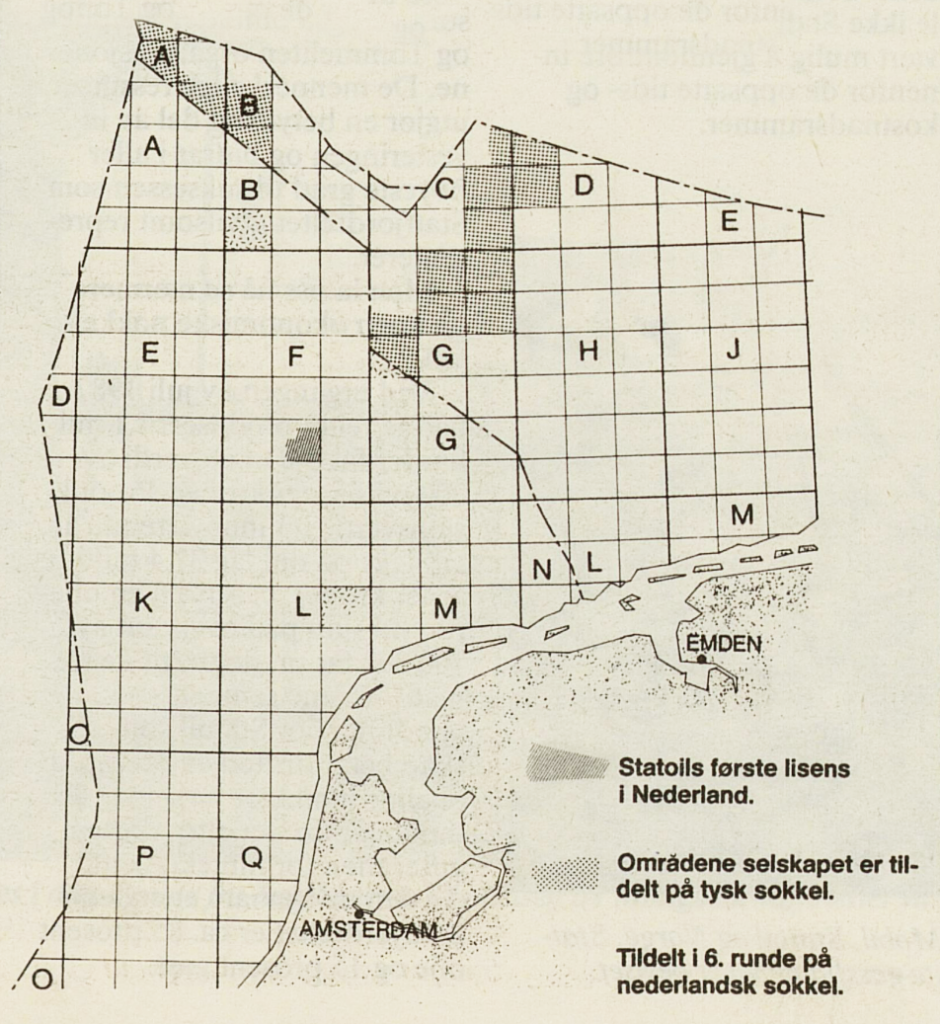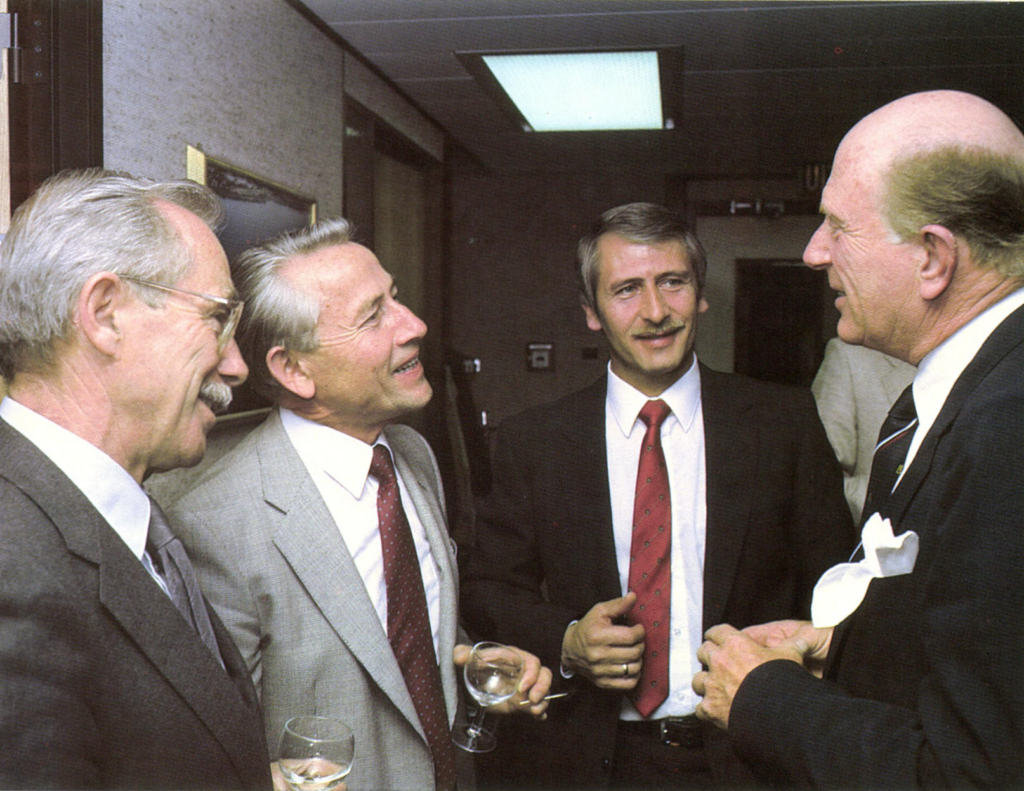First daughter

Statoil was not unfamiliar with the Dutch continental shelf. It had interests in two licences inherited from the Norwegian government after the Storting (parliament) gave its blessing for the company to exercise the state’s option for them in 1982 – with the rights and obligations that this involved.[REMOVE]Fotnote: Ministry of Petroleum and Energy, Proposition no 102 (1981-1982) to the Storting, Om utøvelse av Statoils opsjon til å delta i lisensen K/18-L/16 på nederlandsk kontinentalsokkel m.m.
The assumption was that all revenues generated within the licences were to be transferred to Norway. In addition, the Ministry of Petroleum and Energy felt it was appropriate for Statoil to establish a dedicated subsidiary if the options were exercised.
As a result, the Dutch sector of the North Sea became the first of many foreign continental shelves where Statoil made a commitment. But the international dream there proved relatively short-lived. After eight years, the company sold off everything and left the country.
Acquiring the licences
The Norwegian government secured access as early as 1970 to four licences on the Dutch continental shelf as the result of a swop deal involving Norwegian Gulf Oil Company. When the latter was allowed to transfer its rights in two blocks off Norway to Norske Conoco, one of the conditions was that Conoco’s then US parent, Continental Oil Company, would give the Norwegian state a right to at least 10 per cent in a Conoco licence in a country other than Norway.[REMOVE]Fotnote: The two blocks in the Norwegian North Sea represented two-thirds of production licences 019 (Ula and Gyda) and 020.
The result was that the state acquired 10 per cent of the Continental Netherlands Oil Company (ConNed) holdings in blocks F/7, F/9, K/18 and L/16 in the Dutch sector, which amounted to 7.5 per cent of this acreage.

These blocks were transferred in 1973 to Statoil along with other agreements on state participation which the government had secured at that point.[REMOVE]Fotnote: Proposition no 78 (1972-1973) to the Storting, Utøvelse av statens opsjon på deltakelse i utvinningstillatelse for petroleum (Frigg-feltet), og overføring til Den norske stats oljeselskap A/S av avtaler om statsdeltakelse i utvinningstillatelser m.v.
The decision to transfer all such agreements left the company with options for four Dutch blocks.
Several of the prospects were later assessed by operator Conoco as uninteresting, with F/7 and F/9 as well as half the acreage in K/18 and L/16 being relinquished to the Dutch government.[REMOVE]Fotnote: Proposition no 102, op.cit.
Oil discovered in the remaining area of K/18 in 1980 was declared commercial the following year. Under the agreement originally entered into with the Norwegian state, Statoil then had seven months to decide whether to exercise its option.
While the company was free to decide that it wanted to pull out, any decision on participating in development and operation would be taken by the Storting. When the matter came up for debate there in June 1982, there was no discussion – Statoil was to participate for the first time in oil production on another country’s continental shelf.
With a green light from the Storting, the company opted to participate in developing K/18 in accordance with the plans drawn up by Conoco.[REMOVE]Fotnote: Annual report and accounts 1982, Den norske stats oljeselskap a.s, Stavanger.
Subsidiary

In line with the Storting’s wishes, Statoil established a subsidiary and permanent office in the Netherlands. It also regarded the model of a wholly owned daughter company as the most appropriate way to organise foreign operations.
The advantage of this approach was that subsidiaries abroad could draw on parent company expertise in a flexible and straightforward manner. They were charged for such services at the hourly rates normally applied between oil companies.
Since these foreign arms were Statoil’s own limited companies, they had to comply with the laws of the country they operated in. That in turn meant they had to keep full accounts for their own activities, which had to be confirmed and approved by auditors in the subsidiary’s own country and in Statoil.
K/18, or the Kotter field, came on stream on 22 September 1984, and Statoil began earning revenues from a foreign engagement for the first time. Production from the Logger field in L/16 began a year later.[REMOVE]Fotnote: Status, Statoil house journal, no 8, 1985, “Logger-feltet i produksjon”.
Looking for more
Statoil was keen to participate when new blocks were put on offer in the Dutch sector during 1984. Its board raised the issue of such involvement with the general meeting (the minister of petroleum and energy). Statoil’s preference was to be an operator.
The Dutch authorities had an express desire to develop collaboration with Norway in the oil sector in order to reduce the influence of the big multinational companies.[REMOVE]Fotnote: Status, Statoil house journal, no 16, 1984, “Operatøroppgave i Nederland?”.
Statoil applied for the operatorship of three blocks in this fifth licensing round, and reinforced staffing at the Dutch subsidiary by eight people.
The company secured 60 per cent of block F/14a. According to the Dutch government, it had the best geological interpretation and a good work programme. An award to Statoil would also fit well in a broader energy-policy context. To judge from the number of applications, the blocks sought by the company were the best in the round.
Drilled by American jack-up Zapata Scotian, the initial wildcat on F/14a was Statoil’s first well as operator outside Norwegian waters and was spudded on 8 August 1986.

Oil was encountered in the licence,[REMOVE]Fotnote: Status, Statoil house journal, no 10, 1986, “Oljefunn på nederlandsk sokkel”. but not much. Small oil deposits were also discovered in the neighbouring block, along with gas assumed to be commercial. F/14a proved a disappointment, since the oil found was much less than the company had hoped for.
Statoil nevertheless did not give up, and applied for further licences – securing three operatorships in 1987 and two more in 1989. That meant the company had six operatorships plus participation in the producing Kotter and Logger fields.[REMOVE]Fotnote: Status, Statoil house journal, no 19, 1989.
An end and a new beginning
While Statoil was celebrating its 20th anniversary in 1992, its Dutch involvement terminated. The company sold its remaining exploration licences and the subsidiary there.
It wanted to concentrate its international involvement by making a full commitment to the collaboration project with BP in the former Soviet Union, south-east Asia and west Africa.[REMOVE]Fotnote: Stavanger Aftenblad, 8 April 1993 “Statoil selger i Nederland”.
